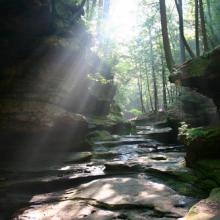Climate Witness
Several weeks ago at the Minnesota State Capitol building, I and a host of others met with senators and representatives to lobby them on environmental issues. When I met with one senator he said he understood the issues and was on my side. It was a love fest. But when asked about working with the Republicans, the love fest ended.
He started rattling off how the other side will not listen, how there is no communication with them, how they are funded by the Koch brothers and will not compromise or even consider any proposals but their own, and so on and so forth. I do not doubt that he was speaking from personal experience, but if he only sees the other as bull-headed then that is exactly what he will get.
As he spoke I kept saying to myself, "There has to be another way of doing this…"
Last week I discovered "a more excellent way" when I re-read The Journal of John Woolman, the spiritual autobiography of the colonial Quaker who I describe as America’s first social mystic. It my seem odd to look to a colonial Quaker as the model for amending climate change — I say amend because we have already changed the climate; the best goal now is to stop further change and amend our way of live — but his model/witness may be the exact model/witness we need.
In my work on environmental causes I have acted primarily from a place of loss, sorrow, and anger, centering on the loss of my family farm in northern West Virginia. In the mid-1980s, the farm was sold to a coal company who stripmined the farms and destroyed the community. I had had dreams of farming that land.
But if I dig deeper through the loss, through the sorrow, and through the anger, I arrive at a place of love. I love creation, I feel I am a part of it, and I want it to flourish because if creation flourishes, all flourishes.
Here is where Woolman’s witness comes in. His social conscience was formed because Love was the first motion. He was simply responding to that Love.
How did he respond? Eighty years before the modern abolition movement of the 1830s, John Woolman began his personal mission to end slavery amongst Quakers in the American colonies.
There’s an old hymn that many Christians have sung for nearly a century. “How Great Thou Art” celebrates the glory of God while considering, “all the works thy hands have made.” It reminds me of the psalm that reads, “The heavens are telling the glory of God; and the firmament proclaims his handiwork. Day to day pours forth speech, and night to night declares knowledge.”
Creation, therefore, is a witness to the wonder and awe of God. Although humanity has been given the honor of bearing God’s image, the earth shows God’s creativity and ingenuity. Over the years I’ve heard so many stories of people finding faith in God, not because of brilliant arguments, but because they are in awe of the complexity and glory of the created world.
But creation is not just a unique witness to God’s glory — it is, as the apostle Paul wrote, “groaning” waiting also for its redemption. This past Easter Sunday, Christians all over the world sang joyful songs of resurrection and renewal. Many of these songs proclaim freedom for all of creation — not just for humanity. One church I know of even sang “Joy to the World,” in celebration that the power of Christ’s resurrection extends “far as the curse is found.”
It’s hard to face, but humanity — image bearers of God — is largely responsible for destroying much of this great witness to God’s glory.

